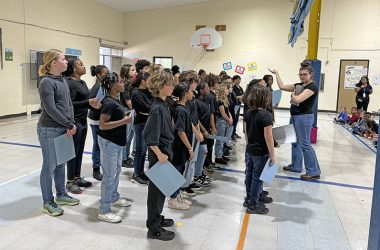The dress code posted outside Juvenile Court is simple.
For boys, no T-shirts, hoodies or sagging pants. For girls, no tight or low-cut attire. Boys are to wear suits or sweaters with collared shirts. Girls are to wear pantsuits, dresses or skirts. School uniforms are acceptable.

Nothing else about Juvenile Court is as simple as that dress code. The courtroom door is locked. Once you’re inside, it’s easy to see why the proceedings are off-limits to casual observers. All justice is a balancing act — just think of that blindfolded lady and her scales. But behind that door the welfare of children, and society, is at stake.
A few months ago I had the opportunity to go to Cook County Juvenile Court. At the Markham courthouse, court proceedings take place in a small room in the basement. There is a bench for the judge and a couple of rows of chairs. Nobody is there unless they are on official business. There are bailiffs and court clerks, lawyers for the defense and prosecution, and police officers acting as witnesses.
Defendants, of course, are allowed in the room and so are parents and guardians.
In all my years as a journalist, there was one accepted article of faith about Juvenile Court. It was strictly off-limits. Reporters had little chance to find out anything that happened behind those locked doors.
After a Sept. 10 attempted carjacking in Homewood, it looked like the H-F Chronicle would be locked out of reporting on what was going to happen to the 17-year-old defendant. You may recall that the teen and another suspect were accused of trying to hijack a car, at gunpoint, from a man in the 18600 block of Klimm Avenue. The victim, an off-duty police officer, fired a round at his assailants, who ran away.
The 17-year-old was arrested at Millennium Park. The other suspect is still at-large.
I was told by two people, one a court official and the other a police officer, that there was no way I could get into Juvenile Court. However, a press officer at the Cook County State’s Attorney’s Office said otherwise. The media, with permission, is allowed into Juvenile Court proceedings, she said.
So I kept looking and finally made contact with Diane Walsh, the legal officer for the Juvenile Justice Division of Cook County Circuit Court. She said I would be allowed to go and made it possible for me to get the necessary permission. I’ll skip the details about how it happened — it got a little complicated — but must add here that I genuinely appreciate her help.
My Juvenile Court session started with Judge Donna Cooper reminding me that the names of young defendants are not to be used. I told her that I understood that condition and would abide by it.
A steady stream of juvenile defendants came before the judge. Unlike the youth in the Homewood case, nearly all were not in custody. Most came in with their parents or other family members. They were all in their teens; some looked very young. The judge asked them all if they understood the charges against them, and also questions about their personal lives, such as subjects they’re taking in school.
One girl was charged with assault for having spit on a police officer. She made a formal apology to him and he said he was satisfied with that outcome. Another girl was facing shoplifting charges. Her defense attorney said the girl — who looked to be about 15 — “hadn’t smoked marijuana for the last year.” A teenage boy was arrested for breaking a car window with a stick and was also charged with trespassing in a house where he was a sometime resident. Judge Cooper dismissed the trespassing charge.
It was easy to see that this was a no-nonsense courtroom. The judge let the teen defendants know that she meant business. But she showed a lot of compassion too.
After nearly two hours, the Homewood defendant was brought into court. He was dressed in a jumpsuit from the county’s juvenile detention center.
There were several minutes of discussion on whether he should be released, with electronic monitoring, so that he could live with his grandmother in Chicago Heights and attend one of the Rich District 227 high schools. At times, it got heated — the assistant state’s attorney said the teen had been involved in past criminal incidents involving guns and was a threat to the community.
I’ve written a few stories about what happened in court that day, and what has happened since. An update is in this issue of the Chronicle. In late September, Judge Cooper ordered the youth’s release, with electronic monitoring. In October, he was arrested for being in possession of a stolen motor vehicle. He was sent back to the juvenile detention center but later released for more electronic monitoring. The state’s attorney’s office says he violated the terms of his release a second time and he is again in custody. This month, the judge found him in contempt of court.
In the last few months, I’ve done a lot of thinking about what, if anything, can be done for a young person who seems as broken as this one. When all the institutions that are supposed to make a difference — family, schools, church — appear to have failed. And when Juvenile Court might offer the last chance to salvage a young life.
I certainly don’t have any answers. I’m not an expert in juvenile justice.
It’s easy enough to say, “That’s enough chances, young man. You’re just bad through and through.”
But I’m glad that someone is trying to salvage kids in trouble. And I hope that what they’re doing works.
This story first appeared in the Jan. 21 print edition of the Chronicle.


